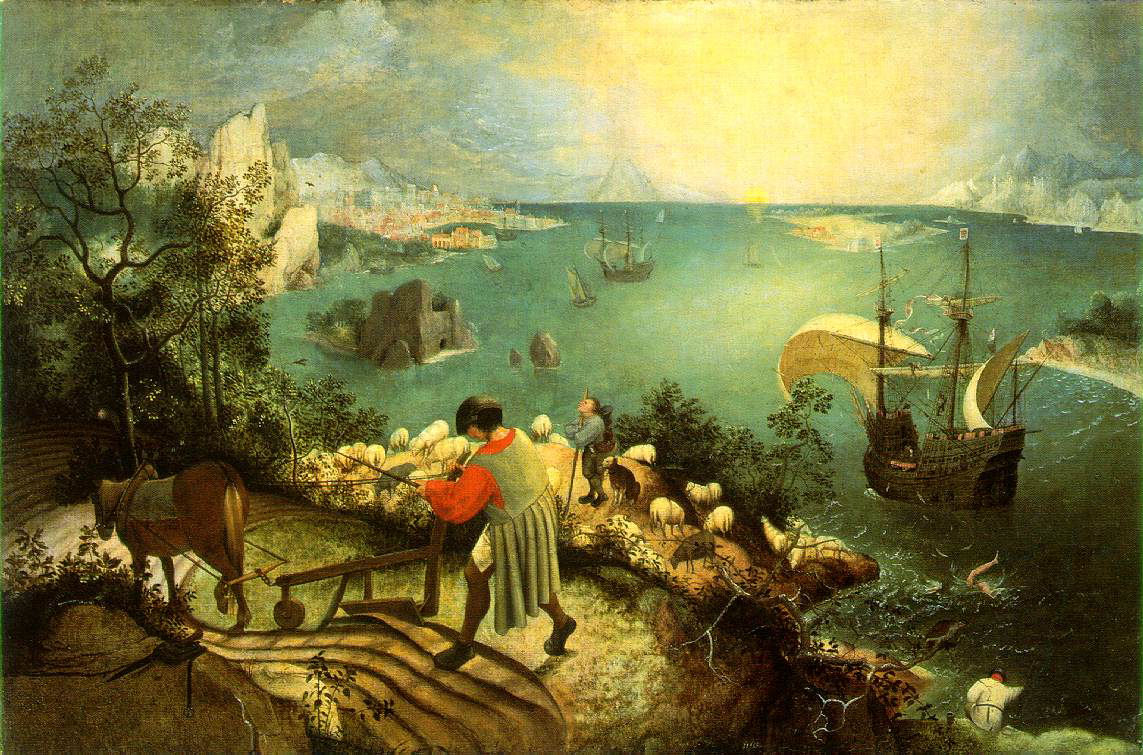Landscape with the Fall of
Icarus
This painting is being used by the Bouwman's
because of the "MAN BEHIND THE PLOW"
Bouwman means "Man behind the Plow" or "Farmer"

Painting is by Pieter Bruegel the Elder. (created
around 1560)
The notable
thing in this painting is
the fact that the anecdote of Icarus’
pride disappears in the margins of the painting.
The
attention is focused on the farmer with his plow, on the shepherd
and his herd, on the harbor and the ships – on the economy, in fact.
The real
transformations are taking place in the society and a mythical hero
such as
Icarus has become marginal.
"Landscape with the Fall of Icarus" touches upon the
Greek myth of the tragedy of Icarus. As we know, according to Ovid and
Appolodorus, Icarus, son of Daedalus, took flight from imprisonment
wearing the fragile wings his father had fashioned for him. Heedless of
his father's warning to keep a middle course over the sea and avoid
closeness with the sun, the soaring boy exultantly flew too close to
the burning sun, which melted his wings so that Icarus hurtled to the
sea and death. The death of Icarus, the poet tells us "According to
Brueghel," took place in spring when the year was emerging in all its
pageantry. The irony of the death of Icarus, who has always been an
emblem for the poet's upward flight that ends in tragedy, is that his
death goes unnoticed in the spring--a mere splash in the sea. The fear
of all poets--that their passing will go "quite unnoticed"--is an old
and pervasive theme. That Williams reiterates the theme is significant
in the life of a poet who always felt the world had never fully
recognized his accomplishments. From: "Modern American Poetry"
"The 'kind' of painting on which
Bruegel concentrated was
scenes from peasant life. He painted peasants merrymaking, feasting,
and
working, and so people have come to think of him as one of the Flemish
peasants. This is a common mistake which we are apt to make about
artists. We
are often inclined to confuse their work with their person. We think of
Dickens
as a member of Mr. Pickwick's jolly circle, or of Jules Verne as a
daring
inventor and traveler. If Bruegel had been a peasant himself he could
not have
painted them as he did. He certainly was a townsman and his attitude
towards
the rustic life of the village was very likely similar to that of
Shakespeare,
for whom Quince the Carpenter and Bottom the Weaver were a species of
'clown'.
It was the custom at that time to regard the country yokel as a figure
of fun.
I do not think that either Shakespeare or Bruegel accepted this custom
out of
snobbery, but in rustic life human nature was less disguised and
covered up
with a veneer of artificiality and convention than in the life and
manners of
the gentlemen [artists such as] Hilliard portrayed. Thus, when they
wanted to
show up the folly of humankind, playwrights and artists often took low
life as
their subject.
"One of the most
perfect of Bruegel's human comedies is his famous picture of a
country wedding. (Peasant
wedding c. 1568 Oil on wood 114 x 164 cm (45 x 64 1/2 in.)
Kunsthistorisches Museum,
Vienna)

Like most pictures, it loses a great deal in
reproduction: all details become much smaller, and we must therefore
look at it
with double care. The feast takes place in a barn, with straw stacked
up high
in the background. The bride sits in front of a piece of blue cloth,
with a
kind of crown suspended over her head. She sits quietly, with folded
hands and
a grin of utter contentment on her stupid face. The old man in the
chair and
the woman beside her are probably her parents, while the man farther
back, who
is so busy gobbling his food with his spoon, may be the bridegroom.
Most of the
people at the table concentrate on eating and drinking, and we notice
this is
only the beginning. In the left-hand corner a man pours out beer - a
good
number of empty jugs are still in the basket - while two men with white
aprons
are carrying ten more platefuls of pie or porridge on an improvised
tray. One
of the guests passes the plates to the table. But much more is going
on. There
is the crowd in the background trying to get in; there are the
musicians, one
of them with a pathetic, forlorn and hungry look in his eyes, as he
watches the
food being carried past; there are the two outsiders at the corner of
the
table, the friar and the magistrate, engrossed in their own
conversation; and
there is the child in the foreground, who has got hold of a plate, and
a
feathered cap much too large for its little head, and who is completely
absorbed in licking the delicious food - a picture of innocent greed.
But what
is even more admirable than all this wealth of anecdote, wit and
observation,
is the way in which Bruegel has organized his picture so that it does
not look
crowded or confusing.

